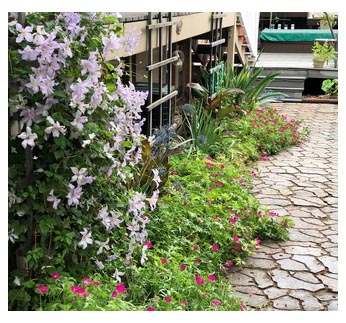By Nancy Kreith
Taking time to select plants for difficult growing conditions helps long-term success
Difficult growing conditions leave gardeners stumped when selecting plants. These planting areas may include alkaline soils, dry shade, over a septic tank, a large local deer population, and more.

Always consider the existing site conditions when selecting new plants for the garden, says Nancy Kreith, University of Illinois Extension horticulture educator. Look at soil conditions, sun exposure, and drainage. Develop a maintenance plan for weeding and watering while establishing plants for the first two years.
“Taking the time to choose plants that suit your unique growing situations can be intimidating, but your work at the start of the project will be rewarded with long-term success. No one likes having to constantly replant an area,” Kreith said.
Kreith has created plant lists of trees, shrubs, grasses, and forbs for challenging site conditions to help ease time and efforts for home gardeners.
For soils that are alkaline, which is common in northern Illinois, aim for plants that are tolerant of a higher pH level and that will help combat nutrient deficiencies. Illinois native plant options include ironwood, chokecherry, bur oak, viburnum, yarrow, purple coneflower, and summer phlox. Other options include smokebush, panicle hydrangea, astilbe, clematis, coral bells, hosta, creeping phlox, and salvia.
In urban areas, construction practices have compacted the soil and exposed clay soil from sub-base layers, but there are plants tolerant of these soils. Native plant options include black chokeberry, red osier dogwood, columbine, New England aster, blue false indigo, purple coneflower, rattlesnake master, wild geranium, blazing star, bergamot, wild quinine, gray headed coneflower, black-eyed Susan, little bluestem, golden alexander. Another option is stonecrop.
Home gardeners should limit their use of water and avoid disturbing soil over septic tanks so chose low-maintenance plants with drought tolerance. Native plant options include butterfly weed, sideoats grama, purple coneflower, prairie smoke, blazing star, wild bergamot, beardtongue, little bluestem and prairie dropseed. Other options are fescue and sedum.
Deer populations are difficult to deal with and even tolerant plants get eaten from time to time. Protect plants with physical barriers after their initial installation. Deer will not eat many nonnative plants such as ageratum, wax begonia, heliotrope, sweet alyssum, daffodil, geranium, blue salvia, dusty miller, and lamb’s ear. Native options are purple coneflower and nannyberry viburnum.
For more information about plant selection, connect with your local Illinois Extension county office at go.illinois.edu/ExtensionOffice.
Nancy Kreith, is a horticulture educator at the University of Illinois Extension.
—Illinois Extension

